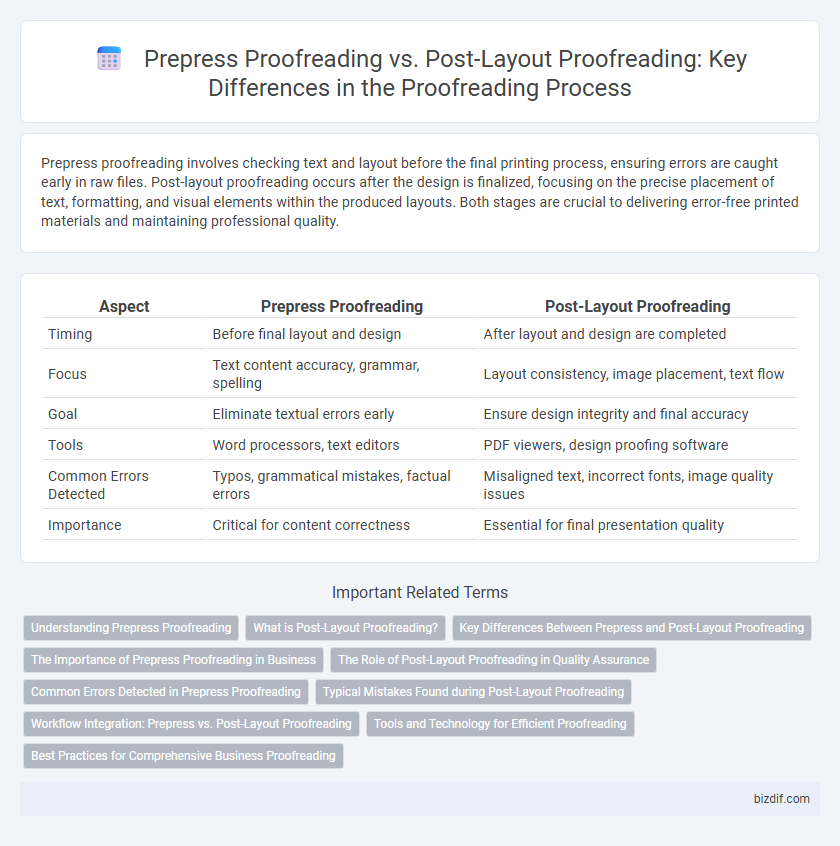Prepress proofreading involves checking text and layout before the final printing process, ensuring errors are caught early in raw files. Post-layout proofreading occurs after the design is finalized, focusing on the precise placement of text, formatting, and visual elements within the produced layouts. Both stages are crucial to delivering error-free printed materials and maintaining professional quality.
Table of Comparison
| Aspect | Prepress Proofreading | Post-Layout Proofreading |
|---|---|---|
| Timing | Before final layout and design | After layout and design are completed |
| Focus | Text content accuracy, grammar, spelling | Layout consistency, image placement, text flow |
| Goal | Eliminate textual errors early | Ensure design integrity and final accuracy |
| Tools | Word processors, text editors | PDF viewers, design proofing software |
| Common Errors Detected | Typos, grammatical mistakes, factual errors | Misaligned text, incorrect fonts, image quality issues |
| Importance | Critical for content correctness | Essential for final presentation quality |
Understanding Prepress Proofreading
Prepress proofreading involves reviewing text and design elements before the final layout is completed to identify errors that can affect printing quality and accuracy. It ensures all copy, graphics, and formatting align with the original content specifications, minimizing costly revisions during post-layout stages. Effective prepress proofreading reduces production delays and maintains brand consistency by catching issues early in the print preparation process.
What is Post-Layout Proofreading?
Post-layout proofreading occurs after the final design and layout of a document are completed, focusing on detecting errors in the formatted pages before printing or publishing. This process ensures that text formatting, font consistency, spacing, and alignment are correct, complementing prepress proofreading, which emphasizes content accuracy before layout. Post-layout proofreading is critical for verifying that no typographical or design errors remain in the final version, preserving the quality and professionalism of the printed material.
Key Differences Between Prepress and Post-Layout Proofreading
Prepress proofreading focuses on reviewing raw text and content before any design or layout elements are applied, ensuring accuracy in spelling, grammar, and factual information. Post-layout proofreading involves checking the finalized design, including typography, formatting, and visual elements, to catch layout errors or inconsistencies that may affect readability or visual appeal. Key differences include the point in the production process when errors are identified, with prepress targeting content accuracy and post-layout emphasizing design integrity and print readiness.
The Importance of Prepress Proofreading in Business
Prepress proofreading ensures the accuracy and consistency of text, graphics, and layout before printing, significantly reducing costly errors and reprints. It enhances brand integrity by catching typos, color mismatches, and formatting issues early in the production process, safeguarding a professional image. Businesses that prioritize prepress proofreading experience improved workflow efficiency and customer satisfaction through error-free final products.
The Role of Post-Layout Proofreading in Quality Assurance
Post-layout proofreading plays a critical role in quality assurance by ensuring that all design elements, typography, and text flow are accurately represented in the final proof before printing. Unlike prepress proofreading, which focuses on textual content and copy errors, post-layout proofreading checks for formatting issues, color consistency, and alignment within the completed layout. Detecting and correcting discrepancies at this stage prevents costly printing errors and guarantees the final product meets publication standards.
Common Errors Detected in Prepress Proofreading
Prepress proofreading primarily identifies text inconsistencies, typographical errors, and incorrect font usage before the final layout is applied, ensuring accuracy in content and formatting. Common errors detected include spelling mistakes, missing or duplicated words, punctuation errors, and incorrect style application, which can lead to costly revisions if overlooked. Catching these issues early in the prepress stage reduces the risk of errors propagating into the final printed or digital product.
Typical Mistakes Found during Post-Layout Proofreading
Typical mistakes found during post-layout proofreading include typographical errors, incorrect font usage, and spacing issues that were not evident during prepress proofreading. Color inconsistencies, image resolution problems, and alignment errors often surface at this stage due to the finalized layout and design elements. These errors impact the overall print quality and brand consistency, making post-layout proofreading essential for ensuring accurate and professional publications.
Workflow Integration: Prepress vs. Post-Layout Proofreading
Prepress proofreading ensures textual accuracy before design elements are finalized, enabling seamless integration with initial workflow stages and reducing costly revisions. Post-layout proofreading focuses on verifying content within the final design format, catching issues related to typography, layout consistency, and visual alignment. Integrating both stages within the production workflow optimizes error detection and streamlines the path from manuscript to print-ready files.
Tools and Technology for Efficient Proofreading
Prepress proofreading relies heavily on automated software tools like Adobe InDesign's Preflight and PDF comparison utilities to detect layout inconsistencies and typographical errors before finalization. Post-layout proofreading benefits from digital annotation platforms such as Adobe Acrobat Pro and collaborative cloud-based proofing tools that streamline real-time feedback and version control. Integrating AI-powered grammar and style checkers enhances accuracy in both prepress and post-layout stages, ensuring efficient and error-free print production workflows.
Best Practices for Comprehensive Business Proofreading
Prepress proofreading focuses on correcting errors in the manuscript stage before design and typesetting, ensuring textual accuracy and consistency. Post-layout proofreading checks the final formatted proofs, identifying issues with layout, typography, and image placement that affect readability and visual coherence. Combining both methods maximizes error detection and maintains professional standards in comprehensive business proofreading workflows.
prepress proofreading vs post-layout proofreading Infographic

 bizdif.com
bizdif.com